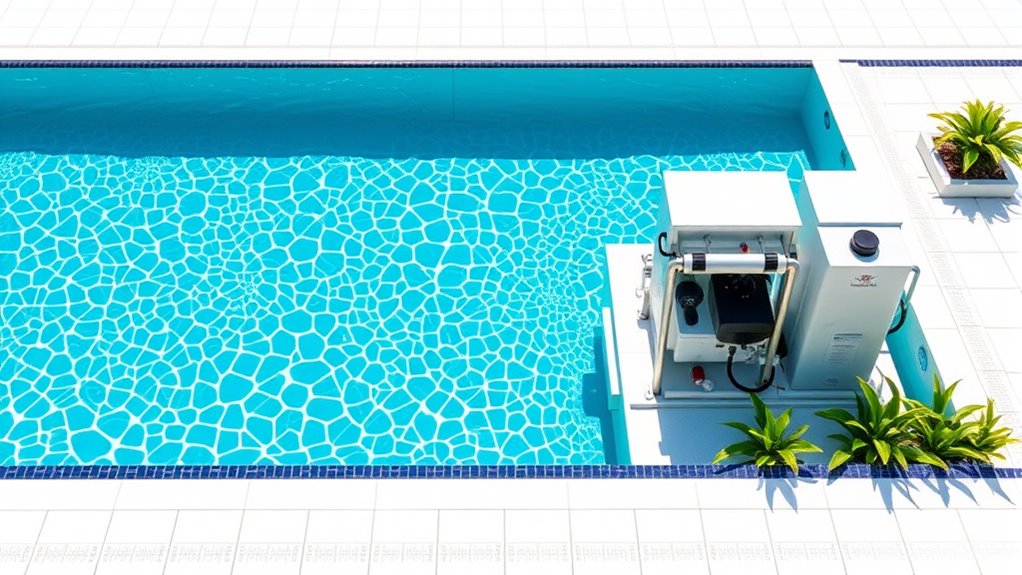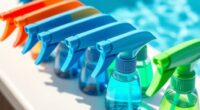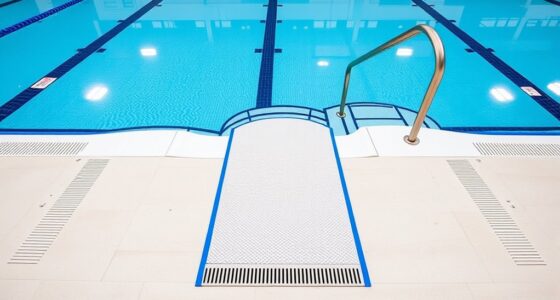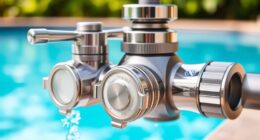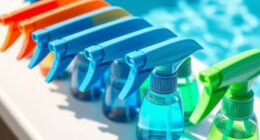To guarantee top water quality in your public pool, regularly monitor and balance chlorine levels between 1.0 and 3.0 ppm to prevent bacteria and irritation. Maintain high-quality filtration by running systems at least 8 hours daily, checking for blockages, and cleaning filters often. Consistent testing, manual inspections, and staff training are essential for safety and clarity. Keep these practices in mind, and you’ll discover more ways to keep your pool clean and inviting.
Key Takeaways
- Regularly test and maintain chlorine levels between 1.0 to 3.0 ppm for safe disinfection.
- Ensure filtration systems operate at least 8 hours daily and are routinely cleaned and checked for blockages.
- Implement routine monitoring and manual inspections to promptly identify and address water quality issues.
- Train staff thoroughly on maintenance, chemical handling, and safety procedures for optimal pool management.
- Secure automated monitoring devices and establish clear protocols to maintain consistent water quality and safety standards.
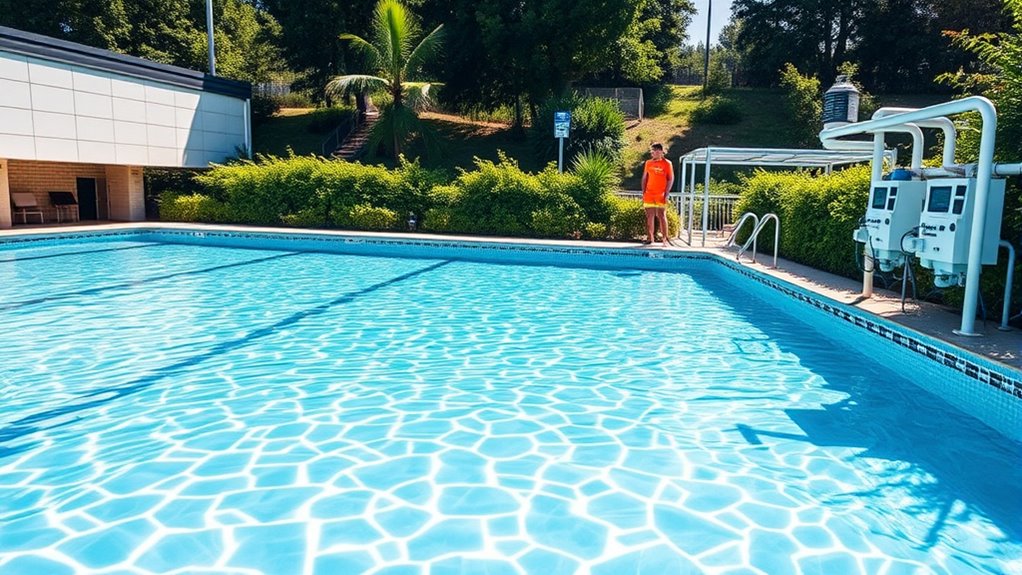
Have you ever wondered how public pools keep their water safe and clean for everyone? It’s a combination of careful monitoring and effective practices that guarantee the water remains inviting and hygienic. One of the most critical aspects is maintaining the proper chlorine balance. When chlorine levels are too low, bacteria, algae, and other contaminants can thrive, making the water unsafe. Conversely, excess chlorine can irritate swimmers’ eyes and skin and cause unpleasant odors. To keep this in check, regular testing is essential. You should check chlorine levels frequently—ideally several times a day during busy periods—and adjust as needed to stay within the recommended range, typically between 1.0 and 3.0 parts per million (ppm). This balance guarantees the chlorine is effective at disinfecting without overdoing it, providing a safe swimming environment for everyone.
In addition to chlorine balance, filtration efficiency plays a crucial role in maintaining water quality. A high-quality filtration system continuously circulates and filters the pool water, trapping dirt, debris, oils, and microorganisms. You need to guarantee the pool’s filtration system is operating at its best, which involves regular backwashing or cleaning of filters, checking for any blockages, and verifying the flow rate. Proper filtration reduces the load on chemical disinfectants, making it easier to maintain the right chlorine levels and preventing the buildup of organic matter. When filtration works efficiently, the water clarity improves, and the chances of contamination decrease markedly. It’s also important to run the filtration system long enough—typically at least 8 hours per day during peak use—to keep the water consistently clean. Additionally, understanding the cybersecurity vulnerabilities that can impact pool control systems underscores the importance of securing automated monitoring devices against digital threats.
Balancing chlorine and maintaining filtration efficiency are interconnected, and both require diligent oversight. You should develop a routine schedule for testing and adjusting chemical levels and inspecting the filtration system. Using automated monitoring devices can help, but manual checks remain essential for accuracy. Additionally, keeping the pool’s skimmers, pumps, and filters in top condition prevents issues before they start. Educating pool staff on proper maintenance procedures and establishing clear protocols ensures these practices are consistently followed. When you pay close attention to chlorine balance and filtration efficiency, you’re actively safeguarding the health of every swimmer and extending the lifespan of your pool equipment. These practices aren’t just operational necessities—they’re the foundation of a safe, inviting swimming environment that encourages people to enjoy the water while staying healthy and protected.
Frequently Asked Questions
How Often Should Pool Water Be Tested for Contaminants?
You should test pool water for contaminants at least twice daily to guarantee safety. Regular water testing frequency helps you monitor contaminants like chlorine, pH, and bacteria levels effectively. By maintaining consistent contaminant monitoring, you can quickly identify and address any issues, preventing health risks. Always record your test results and adjust chemical treatments accordingly, keeping the water clean and safe for all swimmers.
What Are the Most Common Causes of Pool Water Contamination?
Imagine stepping into a pool, only to find murky water clouded by organic debris and chemical imbalances. You cause contamination when swimmers introduce sweat, oils, and dirt, which fuel bacteria growth. Chemical imbalances, like improper pH or sanitizer levels, also invite contaminants. Regular filtration and chemical checks help, but neglecting these causes can turn your pool into an uninviting, unsafe environment. Stay vigilant to keep water crystal clear and healthy.
How Can Algae Growth Be Effectively Prevented in Public Pools?
To prevent algae growth in public pools, you should focus on effective algae control and proper chemical balancing. Regularly test and adjust chlorine levels to maintain sanitizer effectiveness, and keep pH balanced between 7.2 and 7.8. Additionally, guarantee proper filtration and circulation, and brush pool surfaces frequently to remove algae spores. Consistent maintenance and monitoring help keep algae at bay, ensuring clean, safe swimming conditions.
What Safety Measures Should Staff Take During Water Treatment?
A stitch in time saves nine, so you must prioritize safety during water treatment. You should ensure staff are well-trained and maintain vigilant monitoring of the water and equipment. Use proper protective gear, follow established protocols, and promptly address any chemical imbalances. Lifeguard vigilance is essential, as it helps spot potential hazards early. Regular training keeps staff prepared, guaranteeing everyone’s safety while maintaining water quality.
Are There Eco-Friendly Options for Maintaining Water Quality?
Yes, you can use eco-friendly options like natural filtration systems and chemical alternatives to maintain water quality. Natural filtration employs plants and bio-filters to clean water naturally, reducing chemical use. Chemical alternatives, such as mineral sanitizers or UV sterilization, minimize harmful chemicals while still ensuring safe, clear water. By integrating these methods, you promote a healthier environment and provide safer swimming experiences without relying solely on traditional chemicals.
Conclusion
By following these best practices, you become the guardian of a crystal-clear oasis where every swimmer can plunge into safety and refreshment. Think of maintaining water quality as tending to a vibrant garden—your care ensures it blooms with purity and sparkle. When you stay vigilant and proactive, you turn your pool into a sparkling jewel, welcoming everyone to enjoy its pristine waters. Keep these habits close, and your pool will shine bright like a beacon of cleanliness and health.
